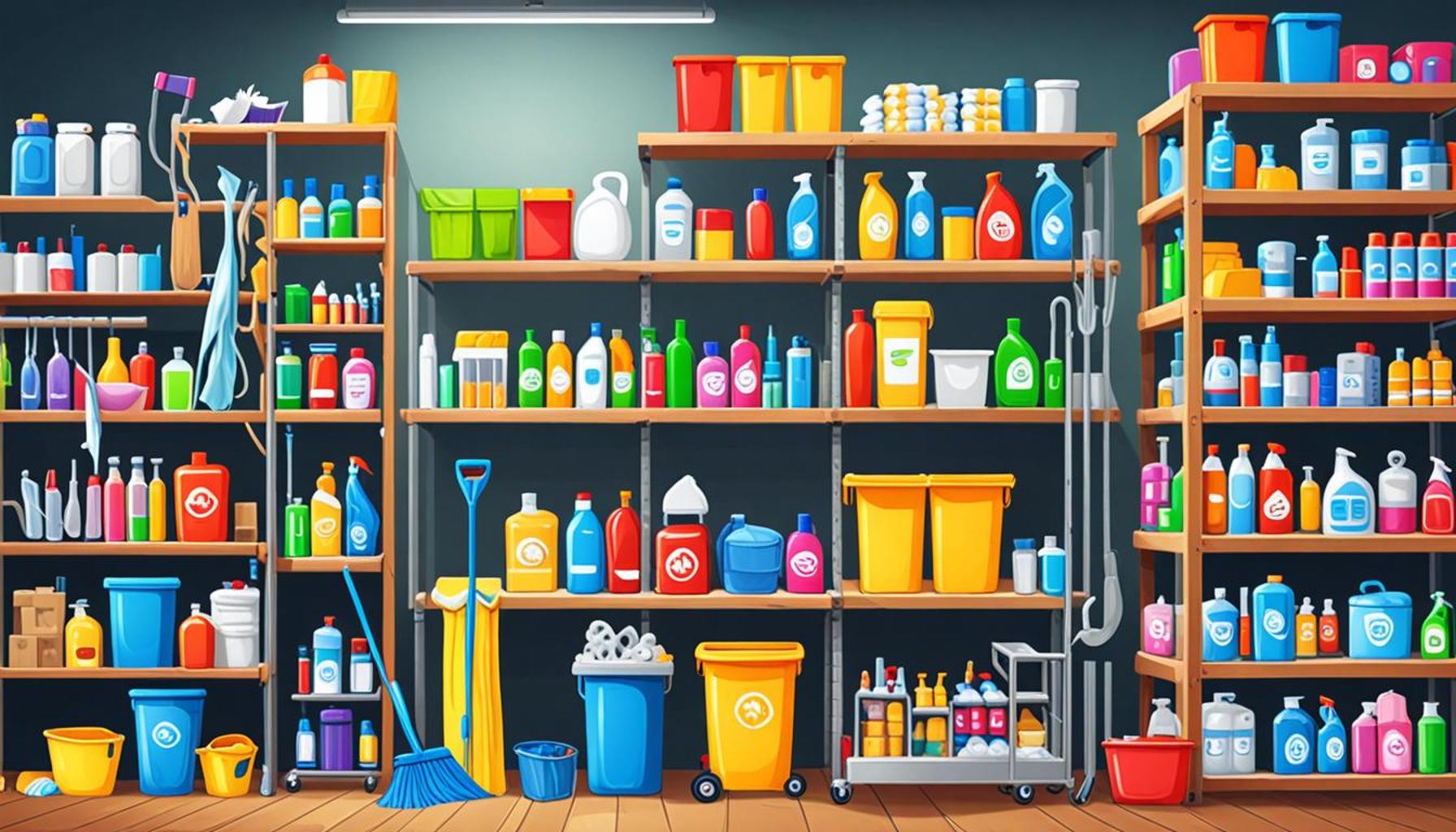Developing a Collaborative Cleaning Schedule for Households with Multiple Members

Understanding Collaborative Cleaning
In today’s fast-paced society, juggling priorities can often lead to domestic neglect. Households with busy schedules can find it particularly challenging to maintain a clean and organized home. Implementing a collaborative cleaning schedule serves as a vital strategy for households striving for cleanliness. This shared responsibility approach promotes teamwork, helping members feel equally invested in the outcome.
An effective cleaning schedule does more than delineate tasks; it enhances communication among family members. Clear assignment of duties clarifies expectations. For example, parents can assign child-specific tasks that are developmentally appropriate, teaching them efficiency while also lightening the adult workload.
Moreover, creating a framework for accountability effectively reduces conflict within the family. When each person knows their responsibilities and there is a system in place to track completion, tension often dissipates. For instance, a family might set aside Sunday mornings to review and update the cleaning roster, promoting a sense of shared ownership.
In addition to improving communication and reducing household strife, a collaborative plan can save time. By coordinating efforts, families can swiftly execute cleaning jobs. This streamlined approach ensures that chores do not become cumbersome. Utilizing methods like assigning specific rooms or areas for everyone promotes systematic cleaning. For instance, one member can focus on the kitchen while another tackles the living room, resulting in effective time management.
To keep the cleaning process engaging and maintain motivation, families can integrate a rewards system. This could be as straightforward as allowing family members to choose a fun weekend activity after accomplishing their cleaning duties, turning a mundane task into a rewarding experience. Additionally, incorporating fun themes or family cleaning competitions can further elevate participation levels.
Research highlights that shared responsibilities in a household lead to a notable decrease in stress and vastly improve interpersonal relationships. By adopting a collaborative cleaning schedule, families can create a cleaner and more harmonious environment where cleanliness breeds collective pride rather than individual burden.
In conclusion, a collaborative cleaning schedule offers families a structured and effective way to manage household cleanliness. With enhanced communication, reduced conflict, and time-saving benefits, this approach not only makes cleaning a family affair but also transforms the house into a welcoming sanctuary for all members.
DISCOVER MORE: Click here to learn about effective strategies
The Building Blocks of a Collaborative Cleaning Schedule
Creating an effective collaborative cleaning schedule involves careful planning and consideration of each household member’s preferences, abilities, and schedules. The first step is to assess the cleaning needs of the home. A thorough audit can uncover areas that require regular attention and can help identify which tasks are often neglected. This initial evaluation is crucial as it sets the foundation for a comprehensive plan that can adapt to the ever-changing dynamics within the household.
Next, it’s essential to initiate a family discussion. Gather all household members—whether it’s parents, children, or roommates—to talk about cleaning responsibilities openly. Engaging everyone in this conversation cultivates a sense of ownership over the cleaning tasks. This also presents an opportunity to motivate family members by discussing the benefits of a clean environment, such as enhanced wellbeing, reduced allergens, and a more inviting space for social gatherings.
Once you have established the needs and garnered input from family members, the next step is to develop a task list. Consider categorizing tasks into daily, weekly, and monthly responsibilities:
- Daily Tasks: Dishes, wiping down surfaces, and tidying common areas.
- Weekly Tasks: Vacuuming, mopping, and cleaning bathrooms.
- Monthly Tasks: Dusting high surfaces, deep cleaning appliances, and organizing closets.
This breakdown allows family members to see what needs to be done and fosters a sense of teamwork. During the planning phase, it’s also critical to assign tasks based on individual strengths and availability. For example, some members might prefer outdoor tasks like yard work, while others excel at indoor chores such as laundry or floor care.
Another key aspect of a successful collaborative cleaning schedule is establishing a rotation system. By regularly rotating tasks, family members won’t feel stuck doing the same chores repeatedly, which can lead to frustration or resentment. Rotations can occur on a weekly or bi-weekly basis, ensuring that cleanliness remains a priority across all areas of the house.
As you finalize the cleaning schedule, be sure to document it visibly within the household. A shared calendar, either digital or physical, can serve as a constant reminder of responsibilities. Additionally, this transparency fosters accountability, as everyone can refer to the schedule and check off completed tasks. Digital platforms like shared Google calendars can help remind family members of their upcoming duties, while a bulletin board in a common area can serve as a motivational visual cue.
Incorporating flexibility into the cleaning schedule also enhances its effectiveness. Life is unpredictable, and some events may temporarily disrupt the cleaning flow. Creating a system where family members can swap chores or adjust the schedule as needed helps maintain a sense of harmony. Offer the option for members to trade tasks or adjust responsibilities if their weekly commitments shift. This adaptability reinforces collaboration and respects each individual’s time constraints.
Benefits of a Collaborative Cleaning Schedule
In households with multiple members, maintaining a clean and organized environment can be a daunting task. However, developing a collaborative cleaning schedule offers numerous advantages that not only streamline cleaning tasks but also foster teamwork among members. Below is a table outlining key advantages that come with adopting a shared cleaning approach.
| Advantage | Description |
|---|---|
| Enhanced Accountability | With each member assigned specific tasks, there is a clear expectation of contributions, leading to increased responsibility. |
| Reduced Conflict | A mutually agreed-upon schedule minimizes misunderstandings about who should clean what and when, decreasing potential disputes. |
By implementing such a schedule, households not only enhance cleanliness but also create a sense of unity and collaboration among their members. This proactive approach to cleaning promotes better communication and fosters a healthier living environment, encouraging everyone to take part actively. Interested in further exploring how to establish this system effectively? Stay tuned for practical tips and tools to get you started!
DISCOVER MORE: Click here for tips on seasonal maintenance
Strategies for Maintenance and Encouragement
Once a collaborative cleaning schedule is established, the next crucial phase is maintaining motivation and consistency among household members. A cleaning schedule can falter if enthusiasm wanes, so integrating strategies for encouragement can make a significant difference. One effective way to keep spirits high is to use positive reinforcement. Acknowledging and celebrating completed tasks can lead to a more engaged household. For instance, setting up a reward system—such as a family movie night or a special dinner—when the schedule is consistently followed can motivate everyone to contribute.
Creating a friendly competition can also add an element of fun to the chores. Households can divide responsibility into teams based on siblings or roommates and track who completes their goals first. Utilizing a points system might involve awarding reading time, screen time, or small rewards that appeal to different ages and preferences. This gamification of chores can foster teamwork while ensuring that everyone remains involved and proactive in maintaining cleanliness.
It’s also essential to conduct regular family check-ins to assess the effectiveness of the cleaning schedule. These meetings can serve as a platform for open dialogue about what aspects of the schedule are working well and what could be improved. During these discussions, household members can voice concerns, share any difficulties they’ve encountered, and suggest adjustments that could lead to a smoother cleaning process in the future. Open communication not only enhances coordination and cooperation but reinforces the sense of shared responsibility.
Incorporating technology can also add efficiency to a collaborative cleaning schedule. App-based task managers, such as Todoist or Asana, can help streamline task assignments and allow all family members to stay updated on their respective responsibilities. Setting reminders through smartphones or integrating smart home devices can ensure that cleaning tasks do not slip through the cracks. Moreover, many of these platforms allow for visualization of progress, which can foster a sense of accomplishment as tasks are completed.
Furthermore, it’s important to include children in the cleaning process as it provides them with valuable life skills. Age-appropriate tasks can teach kids about responsibility and teamwork. For younger children, this might mean simple activities such as putting away toys or dusting tables. Older children might handle vacuuming or helping with meal prep. Programs like “Chore Charts” can be particularly effective, as they give a visual representation of what is expected, making it easier for younger members to engage in household duties.
Maintaining a collaborative cleaning schedule also invites the opportunity for continuous learning about time management and prioritization, as it gives everyone a chance to assess how to allocate their limited time to balance chores with other activities. Families might find that dedicating one day a week for the majority of cleaning fosters a routine—a specific cleaning day can turn chores into a bonding experience. For example, a ‘Saturday cleaning brigade’ can become a regular family time, making the process enjoyable by blasting music and perhaps celebrating the completion with homemade snacks.
Ultimately, the goal is to cultivate an environment where cleaning is considered a shared endeavor that promotes family unity and responsibility. By investing in strategies for maintenance and encouragement, households can thrive, keeping their cleaning routine from becoming a mere list of chores to a meaningful part of their cohabitation experience.
DON’T MISS: Click here to discover essential tools
Conclusion
Creating a collaborative cleaning schedule within a household is more than just organizing chores; it’s an effort that nurtures collaboration, enhances communication, and fosters responsibility among all members. By establishing a structured approach that incorporates various strategies like gamification, positive reinforcement, and regular check-ins, families can transform cleaning from a mundane task into a fun and engaging activity. Such collective effort promotes teamwork and can even strengthen bonds, paving the way for a more harmonious living environment.
The integration of modern technology into household chores cannot be overlooked. Utilizing cleaning apps or smart home devices can not only streamline task management but also keep trends of progress visible, adding an element of accountability. Furthermore, including children in the cleaning process equips them with valuable life skills — responsibility and teamwork in action — that extend beyond household chores to benefit them in their future endeavors.
In essence, a successful collaborative cleaning schedule engenders a culture of shared ownership and pride in one’s living space. As each member contributes to the upkeep of the home, they understand the significance of shared responsibilities and mutual respect. So, gather your household, brainstorm together, and embark on the journey of creating an effective cleaning routine. The path to a cleaner home is not just about chores; it’s about building a thriving family dynamic that appreciates cooperation and fosters lifelong habits.


